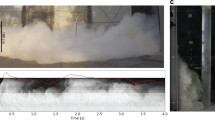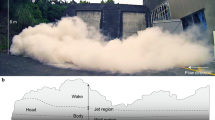Abstract
To account for the level of damage observed following unconfined vapour cloud explosions of the kind that occurred at Flixborough in 1974, flame speeds of the order 102 m s−1 have had to be postulated1,2. Detonations (in which reaction is initiated by adiabatic compression in a shock wave) are not thought to be involved, whilst deflagrations (in which molecular and turbulent transport processes from the flame bring the reactants to a state of rapid reaction) do not seem capable of producing sufficiently high velocities. We suggest here that radiation from a large enough body of burnt products could be sufficient to produce multi-point initiation ahead of the flame by igniting particles, especially those consisting of loose aggregates of fine fibres. Although we thought initially that the hazard would chiefly be due to particles of flammable materials, such as cotton waste and other ‘fluffy’ aggregates of cellulosic substances, we show below that non-flammable materials are also hazardous.
This is a preview of subscription content, access via your institution
Access options
Subscribe to this journal
Receive 51 print issues and online access
$199.00 per year
only $3.90 per issue
Buy this article
- Purchase on Springer Link
- Instant access to full article PDF
Prices may be subject to local taxes which are calculated during checkout
Similar content being viewed by others
References
Briscoe, F. Canvey. Island. Rep. Appendix 1 (HMSO, London, 1978).
Gugan, K. Unconfined. Vapour. Cloud. Explosions (Institution of Chemical Engineers, London, 1978).
Brown, L. E., Wesson, H. R. & Walker, J. R. Hydrocarb. Process. 53, 141 (1974).
Nash, P. Symp: Chem. Proc. Hazards V, Paper D. (Institution of Engineers, 1974).
Hardie, H. C., Lee, D. O. & Benedick, W. B. Combust. Sci. Technol. 17, 189 (1978).
Author information
Authors and Affiliations
Rights and permissions
About this article
Cite this article
Moore, S., Weinberg, F. High propagation rates of explosions in large volumes of gaseous mixtures. Nature 290, 39–40 (1981). https://doi.org/10.1038/290039a0
Received:
Accepted:
Published:
Issue Date:
DOI: https://doi.org/10.1038/290039a0
Comments
By submitting a comment you agree to abide by our Terms and Community Guidelines. If you find something abusive or that does not comply with our terms or guidelines please flag it as inappropriate.



